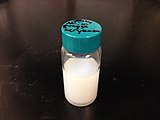Poly(N-isopropylacrylamide)

| |
| Identifiers | |
|---|---|
| ChemSpider |
|
PubChem CID
|
|
CompTox Dashboard (EPA)
|
|
| Properties[1] | |
| (C6H11NO)n | |
| Molar mass | variable |
| Appearance | white solid |
| Density | 1.1 g/cm3 |
| Melting point | 96 °C (205 °F; 369 K) |
| Hazards[1] | |
| NFPA 704 (fire diamond) | |
| Safety data sheet (SDS) | External MSDS |
Except where otherwise noted, data are given for materials in their standard state (at 25 °C [77 °F], 100 kPa).
| |
Poly(N-isopropylacrylamide) (variously abbreviated PNIPA, PNIPAM, PNIPAAm, NIPA, PNIPAA or PNIPAm) is a
PNIPA dissolves in water, however, when these solutions are heated in above their cloud point temperature, they undergo a reversible lower critical solution temperature (LCST) phase transition from a soluble hydrated state to an insoluble dehydrated state. Although it is widely believed that this phase transition occurs at 32 °C (90 °F),[3] the actual temperatures may differ 5 to 10 °C (or even more) depending on the polymer concentration,[3] molar mass of polymer chains, polymer dispersity as well as terminal moieties.[3][4] Furthermore, other molecules in the polymer solution, such as salts or proteins, can alter the cloud point temperature.[5][6]
Since PNIPA expels its liquid contents at a temperature near that of the human body, PNIPA copolymers have been investigated by many researchers for possible applications in tissue engineering[7][8] and controlled drug delivery.[9][10][11][12]
History
The synthesis of poly(N-isopropylacrylamide) began with the synthesis of the
Chemical and Physical Properties
PNIPA is one of the most studied thermosensitive hydrogels. In dilute solution, it undergoes a
Synthesis of Heat and pH Sensitive PNIPA
Homopolymerization[18]
- The process of free radical polymerization of a single type of monomer, in this case, N-isopropylacrylamide, to form the polymer is known as a homopolymerization. The radical initiator azobisisobutyronitrile (AIBN) is commonly used in radical polymerizations.

Copolymerization
- A free-radical polymerization of two different monomer results in a copolymerization. An advantage to a copolymerization includes fine tuning of the LCST.

Terpolymerization
- A free-radical polymerization of three different monomer is known as a terpolymerization. Advantages to a terpolymerization may include enhancing multiple properties of the polymer including thermosensitivity, pH sensitivity or fine tuning of the LCST.

Cross-linked Hydrogel
- The reaction scheme below is a tetramethylethylenediamine (TMEDA) to catalyze the polymerization when making polyacrylamide gels.

Synthesis of Chain-End Functionalized PNIPA
PNIPA can be functionalized using chain transfer agents using a free radical polymerization. The three schemes below demonstrate functionalization using chain transfer agents (CTA), where one end of the polymer is the radical initiator and the other is a functionalized group. Functionalization of the polymer chain-end allows for the polymer to be used in many diverse settings and applications. Advantages to a functionalizing the chain-end may include enhancing multiple properties of the polymer including thermosensitivity, pH sensitivity or fine tuning of the LCST.[18]
Applications
The versatility of PNIPA has led to finding uses in macroscopic gels, microgels,[19] membranes, sensors, biosensors, thin films,[20][21][22] tissue engineering, and drug delivery. The tendency of aqueous solutions of PNIPA to increase in viscosity in the presence of hydrophobic molecules has made it excellent for tertiary oil recovery.
As aqueous solutions of PNIPA have their lower critical solution temperature in temperatures around human body temperatures, these polymers can be dissolved in water at room temperature and administered into body.[23] However, upon the administration, these polymers phase-separate and form insoluble aggregates at site of administration (this process is called thermogelling).[23] When PNIPA is administered into muscles of mice, its half-life was approximately 48 days (Mw = 20 kg/mol) and 66 days (Mw = 32 kg/mol) and caused no local or systemic pathologies.[23] Such phase separated hydrogels can be used for local drug delivery applications.[24] The PNIPA can be placed in a solution of bioactive molecules, which allows the bioactive molecules to penetrate the PNIPA. The PNIPA can then be placed in vivo, where there is a rapid release of biomolecules due to the initial gel collapse and an ejection of the biomolecules into the surrounding media, followed by a slow release of biomolecules due to surface pore closure.[25]
PNIPA have also been used in pH-sensitive drug delivery systems. Some examples of these drug delivery systems may include the intestinal delivery of human calcitonin,[26] delivery of insulin,[26] and the delivery of ibuprofen.[27] When radiolabeled PNIPA copolymers with different molecular weights were intravenously injected to rats, it was found that the glomerular filtration threshold of the polymer was around 32 000 g/mol.[28]
PNIPA have been used in
Furthermore, PNIPA-based thin films can be applied as nano-switches featuring multiple distinct thin-film states, which is based on the cononsolvency effect.[31][32][33]
References
- ^ a b "Poly(N-isopropylacrylamide) Material Safety Data Sheet". sigmaadlrich.com. Retrieved January 24, 2014.
- ^ .
- ^ PMID 26612195.)
{{cite journal}}: CS1 maint: multiple names: authors list (link - ISSN 0065-3195.
- S2CID 238937814.
- PMID 18820735.
- PMID 9860183.
- S2CID 23022529.
- PMID 10518643.
- S2CID 31084515.
- .
- ^ Dang, Steven; Brady, John; Rel, Ryle; Surineni, Sreenidhi; O'Shaughnessy, Conor; McGorty, Ryan (August 2, 2021). "Core-shell droplets and microcapsules formed through liquid-liquid phase separation of a colloid-polymer mixture". arXiv.org. Retrieved March 17, 2024.
- ^ US 2773063
- ^ US 2790744
- .
- doi:10.1103/PhysRevLett.80.4092. Archived from the original(PDF) on July 21, 2011. Retrieved September 25, 2010.
- ISBN 978-0-8247-2154-1. Retrieved February 13, 2014.
- ^ a b "Designing temperature and pH sensitive NIPAM based polymers". sigmaadlrich.com. Retrieved January 25, 2014.
- S2CID 207940427.
- S2CID 155174181.
- S2CID 216346530.
- S2CID 226323489.
- ^ PMID 36153823.
- .
- .
- ^ PMID 17125884. Retrieved March 13, 2014.
- doi:10.1039/b618834f.
- PMID 19176241.
- PMID 31492837.
- S2CID 14317595.
- S2CID 237724968.
- S2CID 234184714.
- S2CID 235560292.













